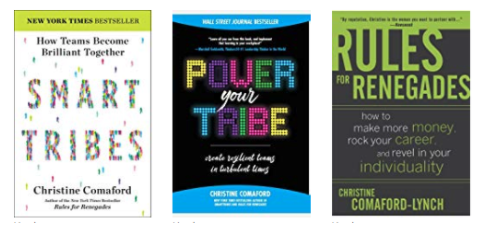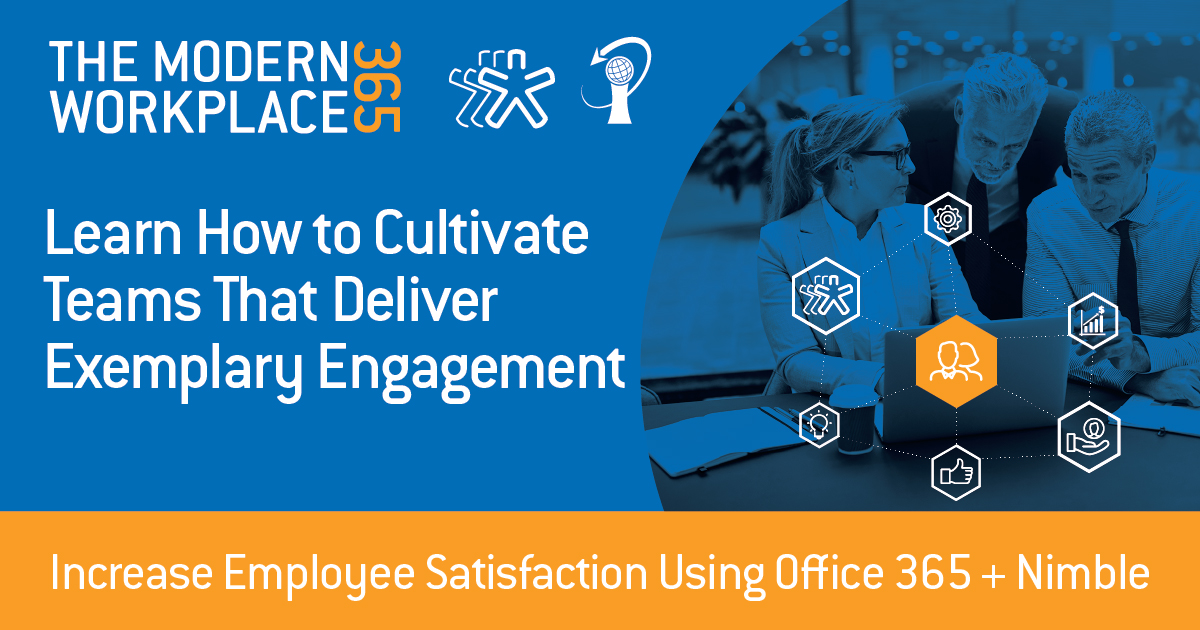Every small business leader wants predictable revenue, profitable growth, and loyal customers. However, in today’s workplace, they often struggle with the cultural and digital transformation that can help make this vision a reality.
How do you create, motivate, and empower teams to deliver extraordinary experiences? What tools do you need to provide in order to facilitate personalized engagement and to help employees scale unforgettable experiences?
In this fifth and final post in The Modern Workplace 365 series, we explore:
- The powerful link between an engaged workforce and an exceptional customer experience
- Leadership strategies that drive motivation and engagement
- Digital tools that enable a culturally diverse workforce to deliver phenomenal outcomes
Businesses today are experiencing both the tremendous growth opportunities and acute challenges brought about by the disrupted digital journey. Today’s self-directed buyer is better informed, has a louder voice (think G2 Crowd, Yelp, and other review sites), and expects an increasingly exceptional experience as a result. Competitors are also launching new products and services faster than ever before, increasing expectations for exceptional Customer Experience (CX).
So, how can small businesses excel?
According to a Temkin Group report, businesses that outperform their competitors in both financial results and customer experience have more engaged workers.
Christine Comaford, leadership and culture coach of SmartTribes Institute and New York Times best-selling author, has written a series of books exploring the relationships between human behavior and performance motivation. Based on first-hand experience helping thousands of business leaders to motivate employee performance, Christine has found that business leaders who align team efforts towards common goals while fostering a deep sense of personal fulfillment can become brilliant together.

She explains: “To engaged employees, the organization’s success is personal. It matters. It’s a reflection of them and what they believe in, who they are, how they show up in the world.”
This commitment is what elevates the company’s engagement to extraordinary levels.
Low unemployment rates, high customer expectations, and the break-neck speed of innovation are driving the market demand for performance motivation coaching.
Christine Comaford is helping thousands of business leaders to recruit, motivate, incentivize, and enable smart tribes. She specializes in human behavior, performance motivation, leadership and marketing/sales, all based on neuroscience. She cites data from the Hoffman Institute indicating more than 90% of our decisions and behaviors are dominated by our emotional brain.
 “Our intellect, which many employers think rules the day, is only responsible for about 10% of our behaviors. Respecting, understanding, and navigating the emotional experience of your team and your customers should never, ever, be trivialized.”
“Our intellect, which many employers think rules the day, is only responsible for about 10% of our behaviors. Respecting, understanding, and navigating the emotional experience of your team and your customers should never, ever, be trivialized.”
According to Christine, neuroscience is the reason why employee engagement (when driven by a deep sense of fulfillment) is such a powerful force.
Christine Comaford’s four-step approach:
- Recruit, develop, and retain the right talent using Impact Job Descriptions and Individual Development Plans (IDP). “An impact job description speaks directly to an individual’s values and the impact they want to have on an organization. Career paths rarely follow an org chart, so business leaders work with associates to create the IDP in order to identify the skills she wants to develop and expand on, help her understand what the organization can do to help her grow, and align those skills with the goals of the company.”
- Understand what motivates each generation so you can align incentives, leadership, and management with these values. “Baby boomers, which make up about 29% of the workforce, put a premium on belonging to and being part of an organization. Generation X, comprising about 34% of the workforce, cares about the safety and wants to have a high confidence level that their role is secure. Millennials are currently 34% of the workforce and are rapidly becoming the largest segment of the workforce as baby boomers continue to retire. Millennials are very focused on making a contribution and seeing that the work they do is a reflection of their values.”
- Incorporate neuroscience into your sales and marketing strategies. “Recognize that buyers, like employees, make decisions based almost exclusively on emotional experience such as safety, belonging, and mattering. They’ll move forward if they resonate with your marketing messages and solutions you deliver.”
- Build and automate value through the systems, technology, and processes you put in place in order to grow. “In order to derive the maximum value from a finite resource (people), it is essential to automate everyday tasks. This makes teams more effective by taking the mundane, non-engaging tasks off their desks so they can focus on high-value, customer-centric activities that really matter.”
People can be slow to adapt to change, and are sometimes resistant to change altogether. To encourage teams to embrace new technologies and processes, they must first understand how the technology will make them more effective; for example, by providing valuable functionality such as social insights or recommended next-steps, making them more efficient by eliminating or reducing mundane tasks, or enabling them to do a better job by making customer data and information easily accessible.
 “People have different priorities, different agendas,” explained Den Howlett, founder of Diginomica. “Some people can see that there’s a need to change. Other people don’t see a requirement for change and need to be persuaded. And those differences open up a whole slew of debates about how would you actually manage the business of change. How do you actually manage the business of innovation, without causing tremendous internal upheaval?”
“People have different priorities, different agendas,” explained Den Howlett, founder of Diginomica. “Some people can see that there’s a need to change. Other people don’t see a requirement for change and need to be persuaded. And those differences open up a whole slew of debates about how would you actually manage the business of change. How do you actually manage the business of innovation, without causing tremendous internal upheaval?”
Den believes there’s much to be learned from millennials, who think much more in terms of value, rather than transactions: “Rather than simply accepting a mandate to use a new technology, they want to understand how it makes their work better and whether it will work as well on their mobile device as on their laptop.”
Ultimately, respecting the unique attributes of each generation in our workforce delivers the best outcomes.
According to Laurie McCabe, co-founder and partner at The SMB Group, seventy-five percent of small and mid-size businesses agree that using technology effectively is critical to their company’s survival and growth.
Fortunately, the technology available to small and mid-sized business is evolving rapidly, and today’s cloud-based business applications provide capabilities that were not within reach of SMBs just a few years ago.
“As vendors embed advanced technologies such as artificial intelligence, machine learning, natural language processing and more into their solutions, SMBs can more easily put these technologies to work to automate routine tasks and get deeper insights into what’s going on in their businesses so that they can better meet the needs of a diverse, highly engaged workforce,” Laurie explains.
Cloud-based applications are ideal for the SMB because they can be implemented more quickly and with a lower up-front investment in financial and human resource. They enable the availability of cutting-edge capabilities that weren’t possible a few years ago. “The cloud has become an on-ramp for SMBs to adopt technologies they otherwise don’t have the time, money, or skills to figure on their own, embed them into their service, and integrate into their systems.”
 Once you have the framework of the business outcome in mind, the next step is to look at how the company envisions using the technology to interact with their customers and improve the customer experience.
Once you have the framework of the business outcome in mind, the next step is to look at how the company envisions using the technology to interact with their customers and improve the customer experience.
“In the B2B world, you have to look at the way that customer-facing teams intend to use the technology when engaging their customers,” explains Jason Bystrak, Vice President, Cloud Business Unit, D&H Distributing. “When implementing a CRM solution like Nimble, for example, you need to think about how exactly you’re enabling employees to engage end-customers more effectively. You’ve got to consider the whole value chain and how you’re going to enhance the experience end-to-end.”
Evaluating and implementing business solutions can be challenging, especially since many technology decisions are being made by business leaders with limited technical acumen and whose primary focus is on feature/functionality and not IT architecture and integration.
The rapid pace of change, the need to align technology with a company’s business model and industry requirements, and the limited availability of staff with the right technical skills make the prospect of evaluating and implementing solutions even more challenging for SMBs.
As Jason explains, there is no simple answer to this challenge, and the contribution that an experienced partner can make here is critical.
 “More and more technology decisions are being made by line-of-business leaders with limited IT experience. At D&H, our role is to help enable channel partners and Managed Service Providers to help business leaders achieve their desired outcomes. By focusing on the business objectives rather than on specific solutions, partners can help customers select the technologies that best meet their needs and deliver their solution in the most time- (and cost-) effective manner possible.”
“More and more technology decisions are being made by line-of-business leaders with limited IT experience. At D&H, our role is to help enable channel partners and Managed Service Providers to help business leaders achieve their desired outcomes. By focusing on the business objectives rather than on specific solutions, partners can help customers select the technologies that best meet their needs and deliver their solution in the most time- (and cost-) effective manner possible.”
– Jason Bystrak, D&H Distributing
The most effective CRM solutions for small business teams and workgroups of up to 25 people are intuitive to use, relatively quick to install, and help to automate repetitive and routine tasks.
Roger Haueter, a modern workplace strategist for iSolutions AG, notes that a Modern Workplace environment can deliver immediate, positive impacts: “The customer experience is significantly improved through the integration of the various data sources into a single version of truth and the use of AI. This can be measured in terms of customer satisfaction as well as in revenue. Employees can retrieve all relevant information from a single application without long wait times or switching back and forth between different systems.”
Here are four things to consider as you motivate and enable employee performance:
1. Passionate employees drive CX excellence and profitable growth.
Your ability to deliver a world-class customer experience is only as good as your ability to cultivate an engaged work culture.
2. Digital transformation delivers tangible value.
Digital transformation is no longer optional. It can drive tangible bottom- and top-line value to your organization, and it may very well be the key to your survival.
3. SaaS makes small business sense.
Cloud-native technologies are bringing game-changing capabilities to your team, and are more affordable and easier to implement than ever.
4. CSPs can lend a helping hand to help you realize your best outcome.
Your organization, like many SMBs, has finite technical insight and resources. A Microsoft cloud service provider (CSP) can add value throughout the digital transformation process.

 Roger Haueter
Roger Haueter
